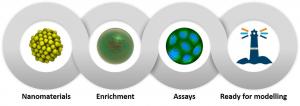Toxicogenomics is a relatively new method that helps us to gain insight into the possible toxicity mechanisms of engineered nanomaterials (ENMs).
While large amounts of transcriptomics data from ENM exposures have already been accumulated, a unified, easily accessible and reusable collection of transcriptomics data for ENMs was lacking”
CYRPUS, June 30, 2021 /EINPresswire.com/ -- A team of scientists involved in NanoSolveIT, an EU nanoinformatics project funded under Horizon 2020, completed a study that was published in Nature journal Scientific Data (https://www.nature.com/articles/s41597-021-00808-y), in order to unleash the full potential of already existing transcriptomics data on ENM exposures. “While large amounts of transcriptomics data from ENM exposures have already been accumulated, a unified, easily accessible and reusable collection of transcriptomics data for ENMs was lacking” says Antreas Afantitis, NanoSolveIT Project Coordinator “The team manually curated, and preprocessed and unified a collection of 101 data sets, covering a range of ENMs, organisms, and exposure setups.”— Antreas Afantitis
As Professor Dario Greco, Director of the Finnish Hub for Development and Validation of Integrated Approaches, at Tampere University says “In an attempt to improve the FAIRness of already existing transcriptomics data for ENMs, we curated a collection of homogenized transcriptomics data from human, mouse and rat ENM exposures in vitro and in vivo including extracting the physicochemical characteristics of the ENMs used in each study from the associated publications.”
The traditional methods of toxicology, used for decades now to scrutinize the safety levels of engineered materials, provide us with a useful tool. However the successful marriage of computer technology and bioinformatics has given birth to a new generation of Toxicogenomics (TGx) tools. Their main function is to collect and store data sets which are further explored and used as the basis for development of predictive models.
The application of TGx data to nanosafety can provide novel possibilities for grouping and classifying ENMs based on the similarity of molecular alterations in biological systems they induce, and help to derive biomarkers to identify nano-specific signatures.
Transcriptomics technologies, used to study an organism as the sum of its RNA transcripts (known as the transcriptome), are the frontline of TGx. While large amounts of transcriptomics data for multiple ENMs have already been generated, offering a valuable resource for future studies and applications, the data are scattered across public repositories, and their FAIRness is currently hampered by their heterogeneous nature and a lack of standardization in the preprocessing and analysis.
The NanoPharos database (https://db.nanopharos.eu/), where all the datasets generated within the H2020 NanoSolveIT (https://www.nanosolveit.eu) and NanoCommons (https://nanocommons.eu/) projects are available, assists accessibility, interoperability and reusability of curated datasets. Antreas Afantitis, from NovaMechanics Ltd and NanoSolveIT H2020 project coordinator, commented: NanoPharos database has been designed under the FAIR data principles to include computationally derived data based on simulations of ENMs at different levels of complexity. The database was further extended to include ENM characterization data and biological effects to support complete in silico nanosafety evaluation.
Antreas Afantitis
NovaMechanics Ltd
+357 99 048039
info@novamechanics.com
Visit us on social media:
Twitter
LinkedIn






